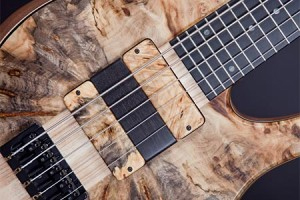Have you ever seen those little blocks between some bass players’ pickups and wondered what they were? Well, as you can see in the above picture it’s called a bass ramp. In the following video I’ll walk you through the steps to build your very own bass ramp.
In the video I’ll discuss what a bass ramp is used for, how much they usually go for, and what exactly you’ll need and have to do to make your own.
Below the video you’ll find the transcript. Feel free to print it out and use it.
And here is the transcript:
Today we’re going to be building a bass ramp. A bass ramp is simply a block of wood or plastic that is placed on the instrument in the pickup area. Bass ramps are typically placed in between the neck pick and the bridge pickup but they can also be made to fit in between the neck and the neck pickup.
The typical function of a bass ramp is to limit the space between the strings and the body of the instrument. Because of this decreased space a bass player using a finger style technique gains quicker recovery time when alternating fingers. This is very reminiscent of how upright bassists play on the neck of their instruments and allows the electric bassist increased performance speed.
Some bassists says that It also helps when you’re muting the strings and using your thumb and other fingers to pluck the strings.
The bass ramp prevents the fingers from digging in too much; training the fingers and forcing the musician to play lighter and in affect they can play faster.
Much like the tone of using a pick, double thumping, or playing finger style close to the neck or close to the bridge affects your tone, bass ramps not only make it easier to play faster but they also aid in giving a bassist the tone of playing up on the fingerboard.
Bass ramps aren’t very common so to get one made for you they can fetch a costly price. I’ve seen some bass ramps go for upwards of 300 dollars. But, look, it’s not rocket science. It’s just a block of wood and you can easily make one yourself.
From what I’ve seen there are about three ways to attach a bass ramp. The most common way is double sided tape. Although this seems low-tech it’s an ideal way attaching it because you can easily take it off when you don’t want it and the tape doesn’t mar the finish of the instrument.
The other way to attach is by creating a floating ramp which means you attach the ramp to the screws that hold the pickups in place. This, to me, seems like it would be a pain to adjust and take off when you don’t want it to be there.
The third way I’ve seen it attach is when you get a bass custom made and the luthier can arrange for the bass ramp to be attached to the body by their own set of screws or other means of attachment.
Today we’re going to make the most common ramp that is simply attached by double sided tape.
Step 1:
Like I said, this isn’t a difficult task. All we’re really doing is cutting a block of wood to fit in between our pickups. However, we have to make sure that the the top side of the ramp is contoured to the same radial curve of the neck.
What does that mean?
Well, every neck (for the most part) has a curve to it. So the first thing you have to do is determine what kind of curve applies to your fingerboard. There is a guide with templates you can download for free at www.jerzydrozdbasses.com. It’s called “The Ultimate Bass Setup Guide” and not only has the templates you can use to determine your fingerboard curve but has other useful information about getting your bass in top shape.
Well, the curvature is measured in inches and is pretty simple to determine. Just download the templates and try each of them out by resting them on your fingerboard. Once you determine which template corresponds with your instrument you now have the template guide to sand down the curvature of your bass ramp.
Why should the bass ramp have a curvature?
Because the strings vibrate in varying degrees and the strings are also adjusted at the bridge to correspond to the curvature of the fingerboard. For example, if your B string isn’t loud enough it’s probably because the string height is adjusted to high. You see, as a string vibrates to make its sound it’s vibrating back and forth, up and down, side to side and you don’t want the string to hit the frets, causing fretbuzz. You also don’t want the strings to hit up against the ramp. In the case of a fretless bass you do want a tiny bit of buzz to give your fretless bass that “whaa” sound that is so specialized to those instruments. But for today, let’s just worry about making a bass ramp.
So download the templates, find which one corresponds with your neck and set it aside for later.
Now we want to measure for the actual size of the ramp.
Measure the distance between the inside of your neck pickup to the inside of your bridge pickup. So we’re just measuring the distance for the space in between the two pickups.
In my case it is 65mm. I use millimeters because I get more of a precise measurement.
Now measure the exact length of the pickups because we want the ramp to fit right in between the pickups, have the same length as it rests beside the pickups, and blend in together as one unit. So they should be the same length as the pickups and should rest snugly in between them.
What about the thickness of the ramp? How far should it be from the strings?
Well if you look at the instrument you’ll see that the height of the strings from the fingerboard is higher at the 24th fret than it is at the 1st fret. So we have to simulate this in the thickness of our ramp. What I do is get my millimeter ruler and place it where the body of the guitar meets the end of the fingerboard and I measure the thickness of how much the fingerboard sticks out of the body. In my case the fingerboard extends upwards 10mm from the body. Since the ramp is going further up on the body you can make it a couple of millimeters thicker than this measurement and sand it down if it is too high. Ideally when the ramp is done you should be able to stick a piece of cardboard between it and the strings.
Step 2:
Now that we have our measurements let’s get our tools in order. This is basic wood cutting we’re doing here so whatever you can get to cut wood is what you’ll use. I bought a piece of oak that was 20mm thick and wide and long enough to be able to cut the excess off. A table saw is great for making straight cuts, but if you don’t have that you should have something like a mitre box. This box will let you clamp the wood down and holds your hand saw in a straight line. You’ll also need an orbital or belt sander. I’m sure you can do the sanding by hand but it’ll take a lot longer. You’ll need a ruler, a pencil, and a square to mark your straight lines for cutting. Hopefully you’ll already have most of these tools because if you have to go out and buy a bunch of new tools just to make a bass ramp you might as well just buy a bass ramp from someone else as power tools can be pretty expensive.
Get a block of wood that works best for you that has enough to cut off or sand off. It doesn’t really matter what type of wood you get as the ramp doesn’t really affect the tone of the instrument. It’s really only meant to assist in playing technique.
By now you should have the dimensions for the ramp.
Score the dimensions to cut, making sure that you draw your lines straight with the square. When you cut the block of wood out make sure you cut on the outside of the line you want to keep. Don’t cut inside the lines. It’s better to sand off the excess than not have enough to work with. Cut the block of wood to the specifications of your instrument leaving a tiny bit extra to sand off to allow for a snug fit.
Step 3:
I had to compensate on my ramp because my pickups have screws on the side. In order for my ramp to fit flat against the body I got a conical grinding tool to notch out the areas on the bottom so the screws wouldn’t push the ramp upwards. You don’t have to use a grinding tool if you have a similar situation. You can notch them out with any type of fine-toothed saw like a fret saw or hacksaw. I used a grinding tool just cause I wanted the notches rounded. If you do have to do this make sure you only notch the wood out of the bottom of the ramp. You want the top to look uniform and even.
Once the block is cut to size, sand down the edges, notch out the areas on the bottom to compensate for any screws and get ready to curve the top out.
Make sure all the edges are smoothed out so it’s comfortable to play.
Step 4:
Now that the block is cut out, the edges are sanded down and you’re able to fit the ramp in between the pickups so the ramp rests flat against the body we have to make a radial curve on the top.
There are a couple of ways to do this. One way is to buy a radius-sanding block that matches the curve of your fingerboard. A radius guide can be bought in some hardware stores or at www.stewmac.com. StewMac.com is an online place you can go to buy anything you need to build or work on your guitars. A radius-sanding guide is a block that you can put sandpaper in and will allow you to smooth out a piece of wood to whatever radial curve you want. So if you’re neck has a 20” radial curve you would buy a 20” radial curve block. Just go to that website, enter in “radius-sanding block” and there you go.
The other way to do it is to eyeball it. Use an orbital or belt sander to sand down a curve and use the radius guide you downloaded to guide you in how much you need to sand off on each side.
Use a piece of sandpaper with a coarse grit to it to make things go faster.
Once you have the curve where you want it, switch to a fine grit sand paper and smooth out the top so it’s nice and slick.
Step 5:
Now you should have a block of wood that fits nice between your pickups, rests flat against the body, has curved sides so it’s comfortable to rest your thumb on, has a curved top that matches the curvature of your fingerboard, and is sanded down to a nice smooth surface.
Now you want to apply stain or paint to it.
Before we apply a layer of stain or paint to the ramp we want to make sure the ramp is the height we want. You can apply one strip of double sided tape to the underside of the ramp and check out if the ramp is the right thickness. If it’s too high you can always sand it down a bit. If it’s too low we can raise it with thicker double sided tape. You can get the thick “application” tape in any store. You’ll probably find it where people buy stuff to hang pictures on a wall. It’s the kind of tape that you have to remove the adhesive strip on one side and is spongy to the touch. This will add about 1mm of thickness. If you need more than 1mm you can always double up on the tape.
Now for the stain.
Remove the tape from the underside of the ramp so it’s easier to paint as it won’t stick to whatever surface that you’re painting on.
I applied a layer of primer to my ramp and then painted it black with acrylic paint. I allowed that to dry and then taped off my initial “J” in white. I then sealed that with a couple layers of Polycrylic finish.
You could also buy any stain that matches the color of your pickups. If you have black pickups then go and get some Ebony stain.
If you’re going to go the stain route then apply the stain to the dry surface of the ramp with a dry cloth. Basically, follow the application directions on the can. Just make sure it’s absolutely dry before putting it on your bass.
Step 6:
Now we’re going to apply double stick tape to the underside of the ramp. Here’s a tip. At this point you should already know how much tape you’re going to use and how thick the tape is going to be.
Apply the tape, stick the ramp where you want, and boom, you’re done.
That wasn’t hard, was it?






[…] I’ve already covered some neat stuff with video as well. Two of my most popular blogs have been: “How To Make Your Own Bass Ramp” […]
Hi there J. My guitar player let me play a custom 6 string bass he had built by Nichols Guitar Co here in Phoenix the other day, which had a ramp on it. I didn’t know about this accessory prior to seeing it on his bass and was impressed by the form and function. Your guide inspired me to build my own rather than have his luthier do it and charge a bunch. Luckily my Carvin Icon 5 listed the fretboard radius as 14″ so its too easy to order a 4″ sanding block from Stew Mac, pick up a walnut sample at a local lumber store and do it myself. I’m estimate less than $30 spent at the end of the day.
Gonna give making a ramp a try on my Ibanez..
Thankx!!
Gary/Hk